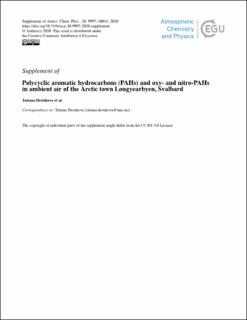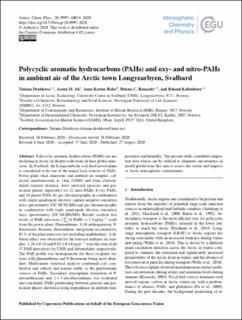| dc.description.abstract | Polycyclic aromatic hydrocarbons (PAHs) are not declining in Arctic air despite reductions in their global emissions. In Svalbard, the Longyearbyen coal-fired power plant is considered to be one of the major local sources of PAHs. Power plant stack emissions and ambient air samples, collected simultaneously at 1 km (UNIS) and 6 km (Adventdalen) transect distance, were analysed (gaseous and particulate phases separately) for 22 nitro-PAHs, 8 oxy-PAHs, and 16 parent PAHs by gas chromatography in combination with single quadrupole electron capture negative ionization mass spectrometry (GC-ECNI-MS) and gas chromatography in combination with triple quadrupole electron ionization mass spectrometry (GC-EI-MS/MS). Results confirm low levels of PAH emissions (Sum 16 PAHs D 1:5 μg/kg coal) from the power plant. Phenanthrene, 9,10-anthraquinone, 9- fluorenone, fluorene, fluoranthene, and pyrene accounted for 85% of the plant emission (not including naphthalene). A dilution effect was observed for the transect ambient air samples: 1.26+/- 0.16 and 0.63+/- 0.14 ng/m3 were the sum of all 47 PAH derivatives for UNIS and Adventdalen, respectively. The PAH profile was homogeneous for these recipient stations with phenanthrene and 9-fluorenone being most abundant. Multivariate statistical analysis confirmed coal combustion and vehicle and marine traffic as the predominant sources of PAHs. Secondary atmospheric formation of 9- nitroanthracene and 2C3-nitrofluoranthene was evaluated and concluded. PAHs partitioning between gaseous and particulate phases showed a strong dependence on ambient temperatures and humidity. The present study contributes important data which can be utilized to eliminate uncertainties in model predictions that aim to assess the extent and impacts of Arctic atmospheric contaminants. | |


